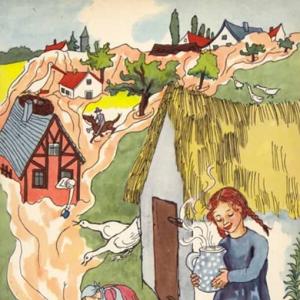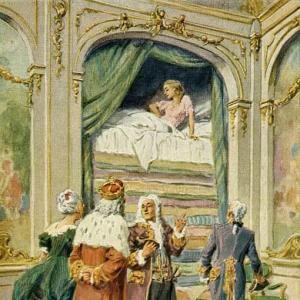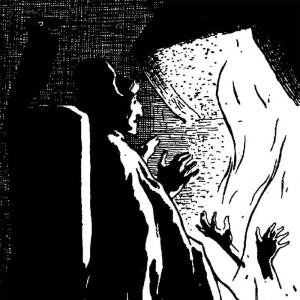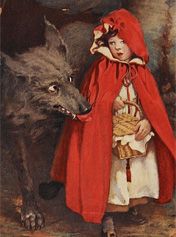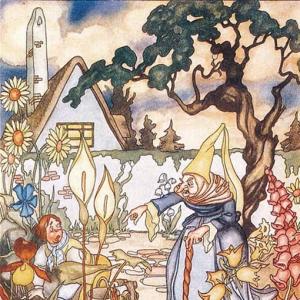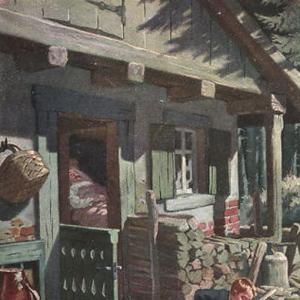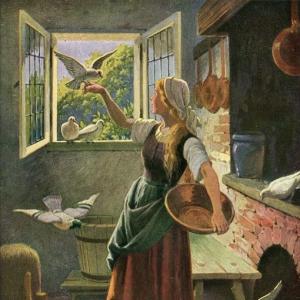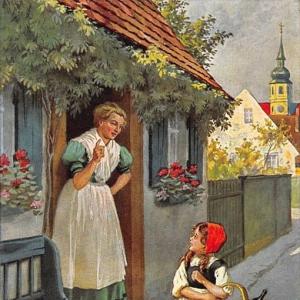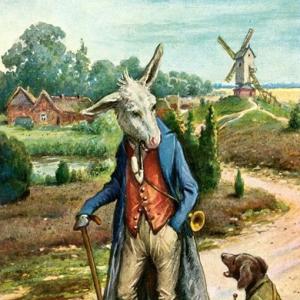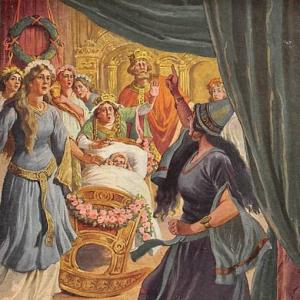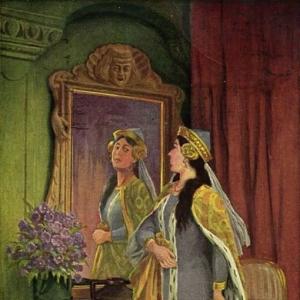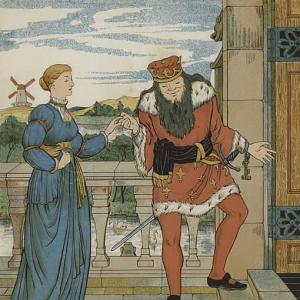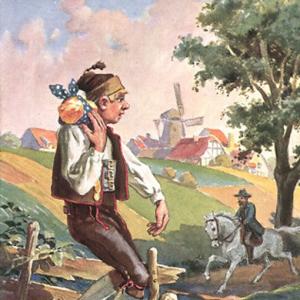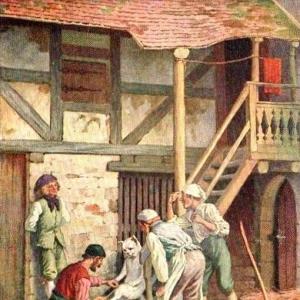Reading time: 17 min
We are up in Jutland, near the wild marsh. We can hear the North Sea, hear it tossing about, for it is quite close by. Before us there rises a great sand dune. We have been looking at it for a long while, and we’ve been, and still are, driving toward it, very slowly, through the deep sand. On the top of this sand dune is an old, rambling building, the Börglum Monastery, the largest wing of which is the church. We arrive there in the late evening, but the air is clear and the night is bright, so we can enjoy an expansive view over meadow and moor as far as the Aalborg Fiord, over field and heath, out over the dark-blue sea.
Now that we are up there, we drive on through barn and shed, then turn through the gates and on into the old castle court, where the linden trees stand in a row along the walls. Sheltered from wind and weather, they thrive here, and their leafy branches almost hide the windows. We climb up the winding stone staircase. We then walk through the long corridors, beneath raftered ceilings. The wind whistles so strangely here, whether outside or inside. One doesn’t quite know where the sounds come from. And then one tells stories. Yes, a person tells and sees so many things when he is frightened or wants to frighten others.
The old dead monks, one says, glide silently past us and into the church, where the wind rushes through and seems to us to be singing Mass for their souls. This brings strange thoughts to one, thoughts that carry us back into the olden times. There is a stranded ship on the coast, and the Bishop’s men are active there on the beach. While the ocean has spared some of the voyagers, these men spare none. The water will wash away all trace of crimson blood that has flowed from broken skulls. The stranded goods – and there are many – all belong to the Bishop. The waves have washed up the anchor and barrels filled with fine wines for the cellar of the monks, where there is already a full supply of ale and mead.
There is also a plenitude of poultry, sausages, and ham in their kitchen, and in the ponds outside are fat bass and delicious carp. The Bishop of Börglum is a man of power. He owns much land and yet he wants to acquire more. All must bow before him, Oluf Glob. A wealthy kinsman of his, at Thy, has just died. The widow will find Oluf Glob neither kin nor kind to her. Her late husband ruled the whole district, with the exception of the church properties. Her son is in a foreign land, having been sent away, at his own wish, when no more than a boy, to learn foreign customs. For years no word has come from him. He may be in his grave and may never return home to take over the rule that now his mother must assume.
„What! Shall a woman rule?“ says the Bishop. He summons her into the courts, but for what gain? She has broken no law. Right and justice are on her side. Bishop Oluf of Börglum, what are you pondering over? What are you writing on that white parchment? What is it that you now conceal under band and seal and then give to a knight and his servant, who ride off with it, out of the country, far away to the city of the Pope? The time of the falling leaves, the season of storms and wrecks, is past, and now icy winter comes. Twice it has come with no tidings from abroad, but now finally with its return the knight and his servant ride back from Rome, bearing a papal ban against the widow who dared oppose the pious Bishop.
„A curse upon her and all that is hers! Cast out is she from church and congregation. None shall dare lend her a helping hand. Friends and kinfolk alike must shun her as a plague and pestilence! What will not bend must break,“ said the Bishop. The people all forsake her. Yet she is steadfast in her trust in God, who alone will be her strength and bulwark. Only one servant, an elderly maid, remains faithful to her. Together they guide the plow over fields where the corn flourishes, though the land has been cursed. „You child of hell, I shall yet carry out my purpose!“ says the Bishop of Börglum. „Now I summon you before the tribunal that will condemn you!“
Then the widow harnesses her last two oxen to her carriage, and she and her faithful servant drive away across the heath, out of the land of Denmark. Now she is a stranger among strangers, where a strange tongue is spoken, and where foreign customs prevail, far away, where the green hills rise into mountains, and where the vineyards grow. Traveling peddlers pass her, carefully guarding their loaded wagons, in deadly fear of attack from robber barons. But the two poor women, in their humble cart drawn by the black oxen, may pass in safety along the dangerous roads and through the dense forests. Now they are in France, and they meet a gallant knight followed by twelve men-at-arms.
The knight pauses and looks at the strange wagon and then asks the younger of the women what country they have come from and what their journey’s destination is. She explains that they are from Thy, in Denmark, tells of her cares and misery, but these all seem to come to an end; our Lord has guided them together – the stranger knight is her son! He holds out his arms and embraces her, and the poor mother weeps, which she has not been able to do for many years, but rather has bitten her lips until blood has come forth. It is the time of the falling leaves, the season of wrecks. The ocean washes ashore filled wine casks for the Bishop’s cellars.
In his kitchen the wild venison is roasting. It is pleasant and warm within doors, though winter freezes without. But news is brought; Jens Glob has returned to Thy with his mother. Jens Glob summons the Bishop into court, to demand their lands and rights. „Much good that will do him!“ said the Bishop. „Spare your efforts, Sir Jens!“ Another year passes, again the time of the falling leaves returns, the season of wrecks. Icy winter follows, and the white bees swarm about and sting one’s face until they melt. It is sharp weather today, say people who have ventured out into it. Jens Glob stands close to his fire, lost in thought. He singes his mantle, burns a hole in it unawares.
„I will master you yet, Bishop of Börglum! You are safe from the law, sheltered by the mantle of the Pope, but not safe from Jens Glob!“ He writes to his brother-in-law, Sir Oluf Hase of Salling, bidding him meet him Christmas Eve at Mass in Hvidberg Church. The Bishop must leave Börglum and come to Thyland, to read the Mass there. This Jens Glob knows. Meadow and moorland are buried beneath ice and snow, and across them speeds a cavalcade of horse and riders – the Bishop, his clerks, his squires. They take the short cut among the waving reeds, where the wind sings its melancholy song. Blow your brazen trumpet, you trumpeter dressed in foxskin!
It sounds sharply in the clear air! They ride on over heath and moorland, where in the warm summertime Fata Morgana decks her magic bowers. On they ride, to the south, toward Hvidberg Church. The wind blows his trumpet, too, blows it louder and louder, creating a storm, a terrible storm, that continues to grow in force. On, on through the storm, toward the church, they ride. The house of God stands firm, but the storm drives on over field and moorland, over fiord and ocean. The Bishop reaches the church. But Sir Oluf Hase can scarcely do so, however hard he rides. He reaches the opposite side of the fiord with his men, whom Jens Glob has summoned to aid him in calling the Bishop to account.
The church is the courthouse. The altar is the counsel table. The candles in the heavy brass candlesticks are all burning. Outside the storm screams out the accusation and the sentence. The wind rushes through the air, over moorland and heath, over the rolling billows. No ferryboat can cross the fiord in such weather. Oluf Hase is held at Ottesund. He dismisses his men, bids them keep his horse and armor and take his farewell to his wife, for alone will he risk his life in the roaring waters. They will be his witnesses that it is not his fault if Jens Glob stands alone in Hvidberg Church. But his faithful warriors will not leave him. They will follow him even into the raging waters.
Ten of them are swept away by the torrent. Oluf Hase and the two youngest reach the opposite shore in safety and have still four miles to ride. It is past midnight, Christmas Eve. The wind has died down. The church is lighted up, the light shining from the windows over meadow and heath. The service is ended, and the house of God is so still that the wax can be heard dripping from the candles to the stone floor. Now at last Oluf Hase arrives. Jens Glob meets him in the forecourt, saying, „God day. The Bishop and I are reconciled now!“ – „Are you, indeed!“ says Oluf. „Then neither you nor the Bishop shall leave this church alive!“
His sword flashes from its scabbard and splits in two the wooden door of the church, which Jens has closed between them. „Hold back, dear brother-in-law! First see what sort of reconciliation this is! I have slain the Bishop and all his men! Not one of them will do evil again, and we need say nothing more of the wrongs done my mother!“ The altar lights burn red, but redder is the stain that shines from the church door. There, lying in blood, is the Bishop, with a cloven skull, and lying dead around him are his men. It is quiet and calm on the holy eve of Christmas.
The third evening after Christmas, funeral bells in Börglum Convent. The murdered Bishop and his slain men lie in state beneath a black canopy, lighted by candelabras swathed in crape. The once mighty lord is a corpse, robed in a silver-bordered mantle, with the crosier in his powerless hand. Incense fills the air as the monks chant a funeral dirge. It sounds like a sentence of wrath and condemnation, and may be heard over the whole countryside as it is carried along and wailed by the wind. Sometimes the accusing voice sinks to rest for a while, but it never dies out completely. It always rises again, carrying its dismal strains late into our own century, singing of the cruel Bishop of Börglum and his wicked men.
On many a dark night the terrified peasant, driving along the heavy sandy road past Börglum Convent, hears it; and the sleepless listener within Börglum’s thick walls hears it, too. The church entrance has long been walled up, but superstitious eyes still see the door there, opening before them. The candles in the church brass crowns shine, and the church is revealed in its former splendor, rich with the smoke of incense, while the monks still sing the funeral Mass for the murdered Bishop. He lies there in his silver-bordered robe, the crosier in his powerless hand, the bloody wound shining as red as fire from his pale, proud forehead. There are the worldly mind and evil passions that burned.
Sink into the grave, into the night of oblivion, you dismal memories of the olden days! Listen to the voice of the wind, sweeping over the rolling sea! Out there a storm is raging and will take many lives, for the sea has not changed its nature because the times have changed. Tonight it is all mouths to devour. Tomorrow perhaps it will be as clear as a mirror, just as it was in the olden times we have now buried. Sleep calmly if you can! Now it is morning. The new day brings sunshine into the room. But the wind still blows, and there is news of a wreck, as in the olden times. Last night, down by Lökken, the little red-roofed fishing village visible from our windows, a ship was wrecked. But by the use of a rocket apparatus a line was cast ashore and a bridge made between the wreck and the mainland. All on board were saved and brought to land, and beds were found for them.
Today they are going to Börglum Convent. There they will find warm hospitality, be sheltered in comfortable rooms, see friendly eyes, and hear kindly voices speaking their own language. The piano will sound for them with melodies of their native land, and before these have died away, a chord of another sort will be struck. Soundless and yet full of sound and certainty, the telegraph wire will reach the homes of the shipwrecked in a foreign land and tell of their safety. Then with their minds at ease, they will join in the dancing at the feast given in the hall at Börglum. Waltzes and folk dances will be danced, and songs will be sung about Denmark and her valiant soldier in our time. Blessed be you, our new age! Let a fresh and pure summer breeze sweep through the towns! Send your sunrays into our hearts and minds! Let them erase the dark traditions of the cruel days of old!
 Learn languages. Double-tap on a word.Learn languages in context with Childstories.org and Deepl.com.
Learn languages. Double-tap on a word.Learn languages in context with Childstories.org and Deepl.com.Backgrounds
Interpretations
Adaptions
Abstract
Summary
Linguistics
„The Bishop of Börglum and His Men“ is a short story written by Hans Christian Andersen, a renowned Danish author who lived from 1805 to 1875. Andersen is best known for his fairy tales, which have become an essential part of children’s literature and have been translated into numerous languages. Some of his most famous works include „The Little Mermaid,“ „The Ugly Duckling,“ and „The Emperor’s New Clothes.“
Andersen also wrote stories for adults, and „The Bishop of Börglum and His Men“ is one such example. This tale, set in the historical context of Denmark, is a mix of history, folklore, and fiction. It tells the story of Bishop Oluf Glob, a powerful and ruthless bishop from the medieval period, who uses his influence to control and manipulate the people around him. When Jens Glob, the nephew of the bishop’s murdered brother, seeks revenge, the story takes on a more sinister tone, illustrating the consequences of power, vengeance, and retribution.
The tale is set at Börglum Monastery, a real historical location in Denmark. Founded in the 12th century, Börglum Monastery served as a center of religious and political power during the Middle Ages. The monastery has a rich and complex history, which includes stories of power struggles, corruption, and violence. Andersen’s story weaves these elements of history and folklore into a captivating narrative, shedding light on the darker aspects of human nature and society. Although Andersen’s stories are often seen as charming and innocent, „The Bishop of Börglum and His Men“ showcases his ability to explore more serious themes and issues, revealing a different side to the author’s literary prowess.
In this story, Andersen explores themes of power, ambition, and the complex relationships among family members, as well as the role of religion and the Church in the lives of the characters. Although it is a work of fiction, the tale’s historical setting and basis in real events provide a unique insight into the lives of the Danish nobility during the Middle Ages. As with many of Andersen’s fairy tales, „The Bishop of Börglum and His Men“ showcases his ability to weave together history, folklore, and vivid imagination to create a captivating story that has endured for generations.
„The Bishop of Börglum and His Men“ can be interpreted in several ways, with themes and messages that resonate across different aspects of human nature and society.
Abuse of Power: The story highlights the dangers of individuals with unchecked power, as seen through the actions of Bishop Oluf Glob. The Bishop’s ruthless actions and attempts to control others demonstrate the negative consequences of power in the hands of those who abuse it. The story highlights the negative effects of unbridled ambition and the desire for power. Bishop Jens and his family become embroiled in a web of deceit and treachery, leading to their eventual downfall. This serves as a cautionary tale, warning readers about the dangers of seeking power for its own sake.
Vengeance and Retribution: Jens Glob’s quest for revenge against the Bishop and his men illustrates the cycle of violence that can be perpetuated when individuals seek vengeance for past wrongs. This theme serves as a reminder of the potential for conflict to escalate and create further suffering.
Resilience and Faith: The widow’s unwavering faith in God, despite the hardships she faces, symbolizes the strength of human spirit and the power of faith to sustain individuals through difficult times. Her resilience in the face of adversity serves as an inspiration and a reminder of the importance of holding onto one’s beliefs and values.
Transformation and Progress: The shift from the dark past to the more hopeful and hospitable present at Börglum Monastery signifies the potential for change and progress within society. Andersen’s call for a celebration of the new age suggests that by letting go of past cruelties and embracing a brighter future, individuals and communities can overcome the challenges of their history and move towards a more compassionate and harmonious existence.
The Power of Stories: Throughout the tale, storytelling plays a significant role in creating atmosphere, preserving history, and inspiring fear or hope. Andersen’s use of stories within the narrative emphasizes their capacity to shape our understanding of the world and influence the way we perceive our surroundings and experiences. Andersen’s tale is not only a work of fiction but also a reflection on the power of storytelling and the importance of preserving historical memory. By blending history, folklore, and imagination, the story serves as a reminder of the enduring impact that narratives can have on shaping our understanding of the past.
Conflict between the Church and the State: The story is set against the backdrop of the struggle for supremacy between the Church and the Crown, a common theme in European history. It highlights the tensions that arise when religious and secular powers clash, and the consequences this can have on individuals and society as a whole.
Family dynamics and loyalty: The relationships among the members of the Hvides family are complex and often strained, as they navigate the challenges posed by their ambitions and the political landscape of the time. This aspect of the story allows readers to reflect on the importance of family bonds and the pressures that can test these connections.
Forgiveness and redemption: Despite the dark and tragic events that unfold throughout the story, Andersen offers a glimmer of hope in the form of forgiveness and redemption. This theme is evident in the way that Bishop Jens eventually repents for his sins and seeks forgiveness from those he has wronged.
Overall, „The Bishop of Börglum and His Men“ presents a complex and layered exploration of human nature, societal dynamics, and the importance of embracing change and progress for a better future. The tale presents readers with a thought-provoking story that explores themes of power, ambition, family dynamics, and redemption, all set against a rich historical backdrop.
„The Bishop of Börglum and His Men“ is a lesser-known fairy tale by Hans Christian Andersen, and as such, it has not received as much attention in terms of adaptations as some of his other works. However, there have been a few adaptations or works inspired by the tale:
Films: The story has been adapted into several films, including a Danish silent film in 1918 and a Swedish film in 1940.
Television: In 2004, a Danish television series called „Biskoppen“ was produced, which was based on the story of the bishop of Börglum and his men.
Theater: The story has been adapted for the stage, including a production by the Royal Danish Theater in Copenhagen in 2014. In 2005, the Danish composer and musician Poul Udbye Pock-Steen composed a musical adaptation of the story, which was performed by the Aarhus Symphony Orchestra. Theater groups, particularly in Denmark, have staged performances of the story as part of broader collections of Andersen’s fairy tales.
Literature: The story has been adapted and retold in numerous books, including a version by Danish author Tom Kristensen, and a children’s book adaptation by author and illustrator Lisbeth Zwerger. Danish author Karen Blixen (also known as Isak Dinesen) mentions „The Bishop of Börglum and His Men“ in her book „Seven Gothic Tales,“ specifically in the story „The Deluge at Norderney.“ The reference to Andersen’s tale serves as a nod to the shared themes of power, ambition, and the corrupting influence of these forces.
Radio play: In 1968, a Danish radio adaptation of „The Bishop of Börglum and His Men“ was produced, bringing the story to life through voice acting and sound effects. The radio play allowed audiences to experience the tale in a new medium and introduced the story to a wider audience.
„The Bishop of Börglum and His Men“ has been adapted in various forms over the years. While there aren’t many high-profile adaptations of „The Bishop of Börglum and His Men,“ the story remains an interesting and important part of Hans Christian Andersen’s body of work. Its themes and historical backdrop offer rich material for potential future adaptations in film, television, or other media. The story has proven to be a popular and enduring tale in Danish literature, inspiring numerous adaptations and interpretations over the years.
The story draws on Danish history and folklore, particularly the legends surrounding the powerful noble family known as the Hvides, who lived during the 12th and 13th centuries. Andersen was inspired by the historical accounts of Bishop and his family’s involvement in the political intrigues and power struggles of their time. The tale is set against the backdrop of the struggle for supremacy between the Church and the Crown, which was a common theme in European history.
„The Bishop of Börglum and His Men“ by Hans Christian Andersen takes place in Jutland, near the wild marsh, where the main setting is Börglum Monastery. The story starts with a shipwreck, and the Bishop’s men killing the survivors to claim the ship’s goods for the Bishop. The Bishop, Oluf Glob, desires to gain more power and land, and becomes embroiled in a conflict with a widow, whose son is away in a foreign land. The Bishop tries to use the Pope’s influence to crush the widow, but she remains strong with her faith in God.
Eventually, her son, Jens Glob, returns and confronts the Bishop. Jens kills the Bishop and his men, taking vengeance for his mother. The story then shifts to the present, where the monastery now offers hospitality to shipwrecked sailors and hosts festivities celebrating Denmark and its people. The tale explores themes of power, vengeance, and the passage of time. As the story shifts from the dark and cruel past to the brighter present, Andersen calls for a celebration of the new age and the erasure of the dark traditions of the past.
„The Bishop of Börglum and His Men“ is a fairy tale by Hans Christian Andersen, which tells the story of Bishop Oluf Glob of Börglum, a power-hungry and ruthless man living in medieval Denmark. The story is inspired by historical events and focuses on the themes of power, ambition, and the consequences of one’s actions. The tale begins with a description of the landscape around the Börglum Abbey, where the bishop lives. The narrator introduces Bishop Oluf Glob, who is described as ambitious and cruel, having a history of conflict with the Danish king and other nobles.
One day, the bishop’s nephew, the knight Sir Bugge, arrives at the abbey with a group of warriors. They plan to rebel against the king, and the bishop decides to support their cause, hoping to increase his own power. However, one of the men in the group is a spy, who reports the bishop’s treachery to the king. Before the rebellion can take place, the king’s forces arrive and capture the bishop. Sir Bugge and his men are killed, and the bishop is imprisoned in a tower for the rest of his life. The bishop, tormented by his ambition and the consequences of his actions, is haunted by the ghosts of his deceased nephew and the other warriors.
Years later, after the bishop’s death, the ghosts continue to haunt the abbey, and the story of Bishop Oluf Glob becomes a legend in the region. The tale concludes with a reflection on the dangers of ambition and the power of one’s past actions to haunt them, even in death. „The Bishop of Börglum and His Men“ serves as a cautionary tale, reminding readers of the potential consequences of unbridled ambition and the importance of considering the impact of one’s actions on others.
Hans Christian Andersen’s „The Bishop of Börglum and His Men“ is a multifaceted fairy tale that intertwines historical themes with the supernatural, capturing the essence of medieval power struggles, justice, and redemption. Linguistically, the narrative employs several layers to evoke emotion, setting, and moral introspection.
Tone and Mood:
Andersen’s use of descriptive language sets a somber and foreboding tone, reflecting the dark and ominous themes of the tale. The narrative begins with vivid imagery of the harsh Jutland landscape and the ever-present North Sea, reinforcing a mood that’s both wild and untamed, aligning with the story’s themes of nature’s unpredictability and human cruelty. As the story progresses, the tone shifts to darker hues, especially in the recounting of the Bishop’s tyranny and his eventual downfall.
Imagery and Symbolism:
The story is rich with imagery, especially when describing the landscape and the supernatural elements. The sand dunes, the stormy sea, and the winds are all deeply symbolic, representing both nature’s impartial justice and the tumult within human hearts. The recurring motif of seasons—particularly the „time of the falling leaves“ and winter—serves as a metaphor for decay, moral decline, and the passing of time.
Water, as both a life-giving and destructive force, frames the narrative, from shipwrecks that benefit the Bishop’s greed to the perilous waters that challenge the knight. This duality emphasizes themes of survival and morality.
Characterization and Dialogue:
Characterization is handled through both direct narration and dialogue. The Bishop is painted as a classic villain through his interactions and the consequences of his actions. His lust for power and control is depicted through articulate and authoritative dialogue. In contrast, the widow’s resolve is highlighted through her steadfastness and trust in divine justice, showcasing her as a symbol of perseverance and faith.
The sparse dialogue enhances the dramatic tension and allows the story to remain rooted in oral tradition, where actions speak louder than words. When dialogue is present, especially in confrontational moments, it is charged with emotion and decisiveness, driving the narrative forward.
Narrative Technique and Structure:
Andersen employs a third-person omniscient narrative, allowing for extensive insights into both the internal and external conflicts within the story. This perspective enables the reader to understand not just the actions, but also the motivations and emotions of the characters. The narrative is layered, juxtaposing the past with the present, which not only creates a mystical ambiance but also underscores the timeless nature of the moral lessons.
The structure of the tale—beginning with vivid setting descriptions, moving through rising action and climax with the bishop’s downfall, and concluding with a reflection on the passage of time and change—mirrors a moral journey, guiding the reader through a landscape of ethical and spiritual exploration.
Themes and Moral Implications:
The story is a reflection on justice, power, and redemption. It contrasts the temporal power of the Bishop with the enduring moral truth embodied by the widow and her son. The supernatural elements, such as the restless spirits of the monks and the weather’s role in the narrative, suggest an otherworldly, impartial justice that prevails over human corruption.
In conclusion, Andersen’s linguistic mastery in „The Bishop of Börglum and His Men“ weaves together a timeless tale of human frailty and resilience. Through rich imagery, symbolic motifs, and a keen sense of moral inquiry, the fairy tale becomes more than just a story—it becomes a meditation on the past’s influence on the present and the enduring quest for justice.
Information for scientific analysis
Fairy tale statistics | Value |
|---|---|
| Readability Index by Björnsson | 28.9 |
| Flesch-Reading-Ease Index | 82.2 |
| Flesch–Kincaid Grade-Level | 5.4 |
| Gunning Fog Index | 7.5 |
| Coleman–Liau Index | 9.2 |
| SMOG Index | 7.8 |
| Automated Readability Index | 5.9 |
| Character Count | 12.623 |
| Letter Count | 9.865 |
| Sentence Count | 158 |
| Word Count | 2.324 |
| Average Words per Sentence | 14,71 |
| Words with more than 6 letters | 330 |
| Percentage of long words | 14.2% |
| Number of Syllables | 3.013 |
| Average Syllables per Word | 1,30 |
| Words with three Syllables | 98 |
| Percentage Words with three Syllables | 4.2% |

 Facebook
Facebook  Whatsapp
Whatsapp  Messenger
Messenger  Telegram
Telegram Reddit
Reddit